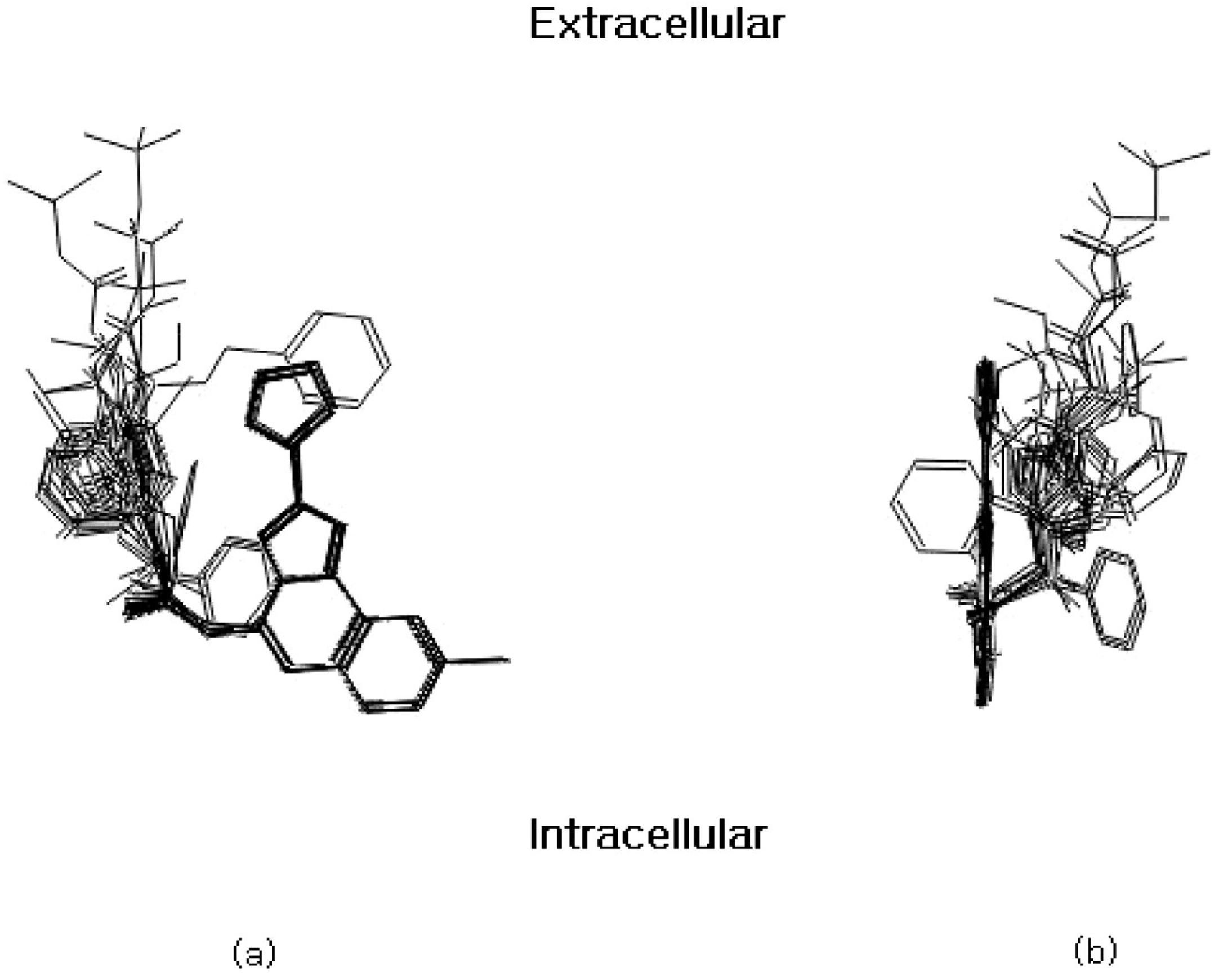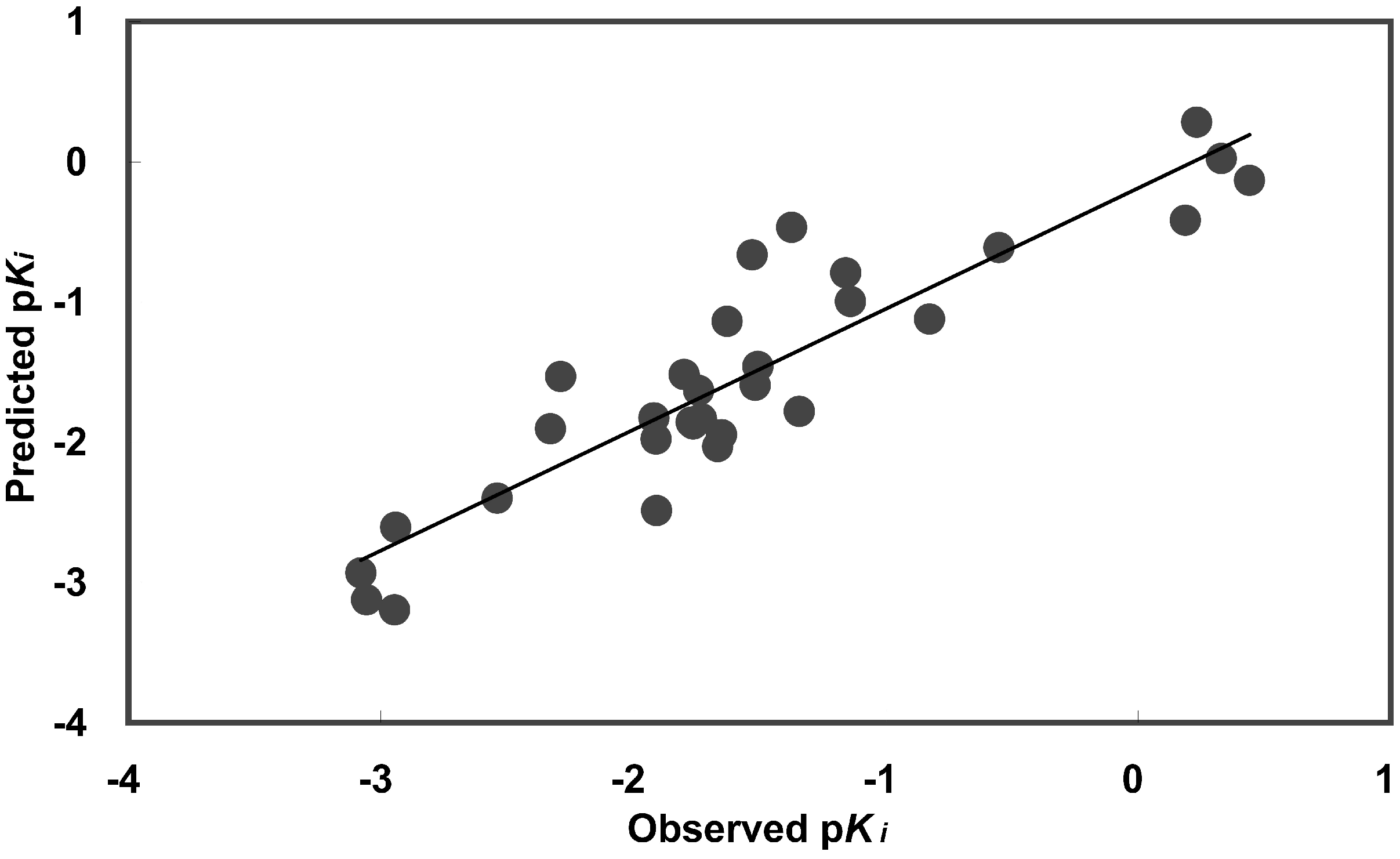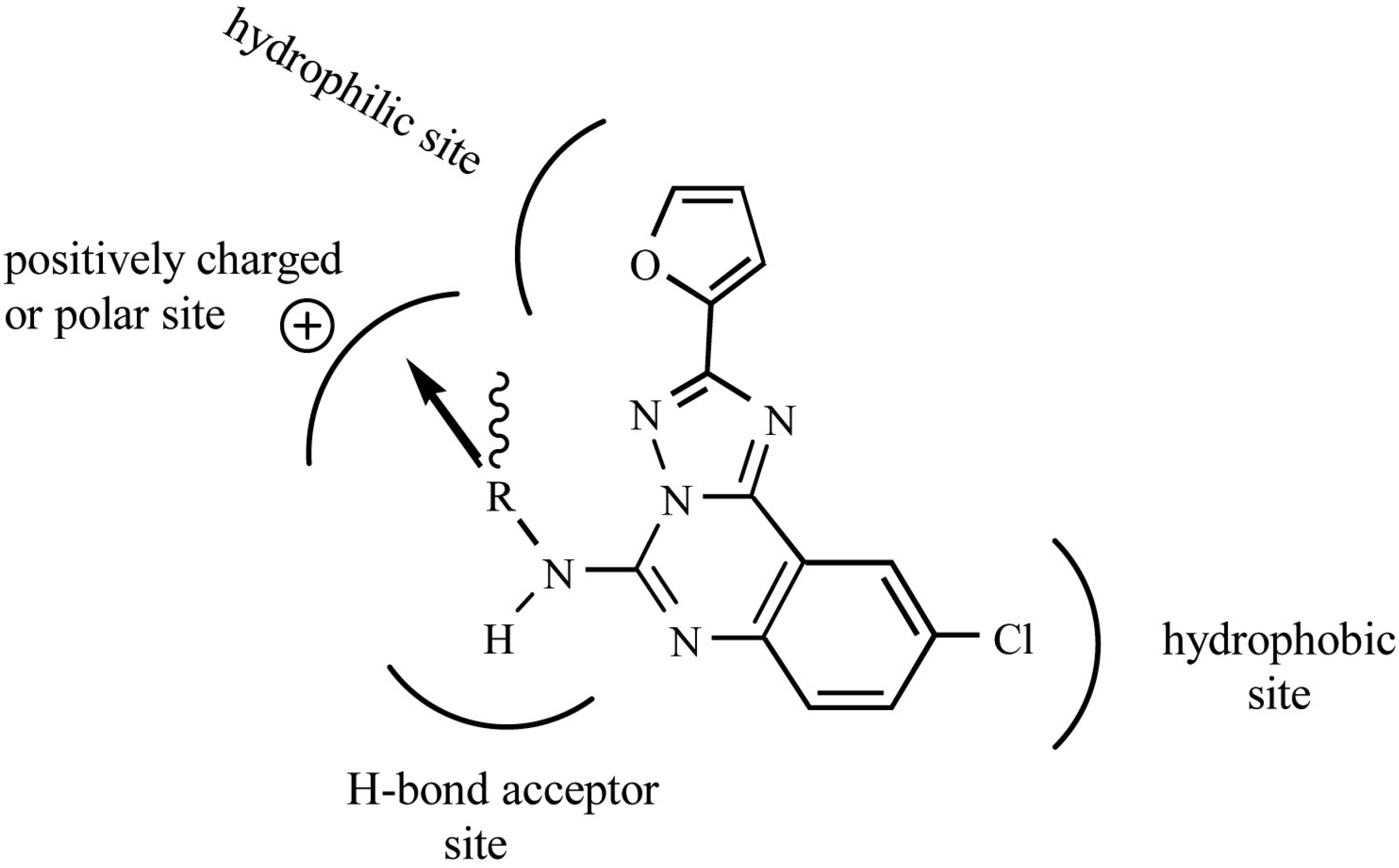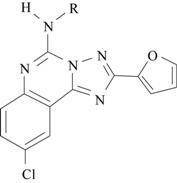Triazoloquinazolines as Human A3 Adenosine Receptor Antagonists: A QSAR Study
Abstract
:1. Introduction
2. Methods
2.1. Data Set

2.2. Full Search Multiple Linear Regression Method
 ,
,
 ,
,
 is the sum of the squares about the regression, and
is the sum of the squares about the regression, and  is the sum of the squares about the mean.
is the sum of the squares about the mean. ,
,
 and n is the number of observations, k is the number of variables, and r is the correlation coefficient.
and n is the number of observations, k is the number of variables, and r is the correlation coefficient.
2.3. Selection of Outliers
3. Results and Discussion
3.1. Derivation of QSAR
| Outliers | None | 15 | 5,15 | 5,14,15 | |||||||||
|---|---|---|---|---|---|---|---|---|---|---|---|---|---|
| No of Terms | r2a | sb | Fpc | r2a | sb | Fpc | r2a | sb | Fpc | r2a | sb | Fpc | |
| 1 | 0.23 | 0.82 | 9.49 | 0.25 | 0.82 | 10.15 | 0.26 | 0.83 | 10.25 | 0.26 | 0.84 | 9.95 | |
| 2 | 0.37 | 0.75 | 6.59 | 0.40 | 0.75 | 7.02 | 0.41 | 0.75 | 7.14 | 0.42 | 0.76 | 7.07 | |
| 3 | 0.49 | 0.69 | 6.69 | 0.50 | 0.69 | 5.76 | 0.52 | 0.69 | 5.82 | 0.53 | 0.70 | 6.09 | |
| 4 | 0.54 | 0.66 | 3.24 | 0.60 | 0.63 | 6.61 | 0.62 | 0.62 | 7.56 | 0.64 | 0.62 | 7.68 | |
| 5 | 0.61 | 0.63 | 4.29 | 0.75 | 0.51 | 16.09 | 0.82 | 0.44 | 27.16 | 0.86 | 0.40 | 36.01 | |
| 6 | 0.69 | 0.57 | 6.60 | 0.78 | 0.49 | 3.15 | 0.84 | 0.42 | 3.31 | 0.87 | 0.38 | 3.67 | |
| No. of terms | Outlier | r2a | sb | Fc |
|---|---|---|---|---|
| 1 | 14 | 0.33 | 0.77 | 14.50 |
| 2 | 14 | 0.42 | 0.73 | 10.63 |
| 3 | 14 | 0.54 | 0.66 | 11.08 |
| 4 | 14 | 0.63 | 0.60 | 11.54 |
| 5 | 15 | 0.75 | 0.49 | 15.80 |
n = 31, r2 = 0.820, r2cv = 0.716, s = 0.440, F = 22.805

| No | Substituents(R) | Obsd | Pred | Resd | L | B1 | B3 | FPSA3 | ρ |
|---|---|---|---|---|---|---|---|---|---|
| 1a | H | -1.14 | -1.10 | -0.04 | 1.70 | 1.20 | 1.20 | 0.11 | 1.29 |
| 1b | COCH2-Ph | 0.19 | -0.50 | 0.69 | 8.51 | 2.13 | 4.50 | 0.09 | 1.22 |
| 3 | CH2-Ph | -1.63 | -1.28 | -0.35 | 4.61 | 1.70 | 5.98 | 0.09 | 1.24 |
| 4 | COCH2-(4-CH3O-Ph) | -1.16 | -0.86 | -0.29 | 8.86 | 1.90 | 6.61 | 0.09 | 1.22 |
| 5 | COCH2-(4-NH2-3-I-Ph) | -1.69 | -3.37 | 1.67 | 8.44 | 1.91 | 6.34 | 0.09 | 1.49 |
| 6 | COCH2-(4-NH2-Ph) | -0.55 | -0.65 | 0.10 | 9.38 | 1.94 | 4.66 | 0.10 | 1.22 |
| 7 | COCH2-(3-I-Ph) | -2.95 | -3.15 | 0.20 | 8.50 | 2.05 | 5.94 | 0.08 | 1.49 |
| 8 | COCH2-(4-I-Ph) | -1.80 | -1.51 | -0.29 | 9.93 | 1.91 | 4.83 | 0.08 | 1.50 |
| 9 | COCH2-(3-Cl-Ph) | -1.51 | -1.50 | -0.01 | 8.50 | 2.10 | 5.54 | 0.09 | 1.27 |
| 10 | (R)-COCH(CH3)(Ph) | 0.44 | -0.25 | 0.69 | 7.55 | 1.81 | 5.27 | 0.09 | 1.21 |
| 11 | (S)-COCH(CH3)(Ph) | 0.33 | -0.11 | 0.44 | 7.55 | 1.81 | 5.27 | 0.09 | 1.20 |
| 12 | COCH(Ph)2 | 0.23 | 0.14 | 0.09 | 8.31 | 2.02 | 5.18 | 0.08 | 1.19 |
| 13 | COC(CH3)(Ph)2 | -2.29 | -1.60 | -0.69 | 8.20 | 2.32 | 6.41 | 0.09 | 1.18 |
| 14 | COCH2CH2-Ph | -1.37 | -0.47 | -0.91 | 6.81 | 1.82 | 5.59 | 0.09 | 1.21 |
| 15 | COCH=CH-Ph (trans ) | -1.86 | 1.12 | -2.98 | 8.17 | 1.72 | 3.68 | 0.09 | 1.22 |
| 16 | D-COCH(CH3)(NH-Boca) | -1.67 | -2.01 | 0.35 | 9.65 | 2.19 | 6.07 | 0.10 | 1.20 |
| 17 | L-COCH(CH3)(NH-Boca) | -1.92 | -1.82 | -0.10 | 9.65 | 2.19 | 6.07 | 0.10 | 1.20 |
| 18 | CO(CH2)2-NH-Boca | -0.83 | -1.13 | 0.30 | 10.15 | 1.91 | 6.37 | 0.11 | 1.20 |
| 19 | CO(CH2)3-NH-Boca | -1.52 | -1.61 | 0.09 | 10.00 | 1.87 | 8.44 | 0.11 | 1.18 |
| 20 | CO(CH2)4-NH-Boca | -1.34 | -1.78 | 0.44 | 10.51 | 1.88 | 9.38 | 0.11 | 1.17 |
| 21 | CO(CH2)5-NH-Boca | -1.53 | -0.66 | -0.87 | 13.23 | 1.89 | 8.77 | 0.11 | 1.16 |
| 22 | CO(CH2)6-NH-Boca | -1.73 | -1.81 | 0.08 | 12.34 | 1.88 | 11.00 | 0.11 | 1.14 |
| 23 | D-COCH(CH3)(NH2) | -3.06 | -3.11 | 0.05 | 4.94 | 2.05 | 3.88 | 0.10 | 1.24 |
| 24 | L-COCH(CH3)(NH2) | -3.08 | -2.93 | -0.15 | 4.94 | 2.05 | 3.88 | 0.10 | 1.25 |
| 25 | CO(CH2)2-NH2 | -2.94 | -2.59 | -0.35 | 5.55 | 1.89 | 3.49 | 0.11 | 1.24 |
| 26 | CO(CH2)3-NH2 | -1.91 | -2.44 | 0.54 | 7.10 | 1.90 | 3.84 | 0.11 | 1.22 |
| 27 | CO(CH2)4-NH2 | -1.76 | -1.85 | 0.08 | 8.28 | 1.89 | 4.58 | 0.11 | 1.20 |
| 28 | CO(CH2)5-NH2 | -2.33 | -1.88 | -0.45 | 8.94 | 1.89 | 5.69 | 0.11 | 1.18 |
| 29 | CO(CH2)6-NH2 | -2.54 | -2.37 | -0.17 | 8.08 | 1.89 | 6.28 | 0.12 | 1.17 |
| 30 | CO(CH2)4-COOCH2Ph | -1.65 | -2.02 | 0.37 | 7.93 | 1.89 | 9.80 | 0.10 | 1.19 |
| 31 | CO(CH2)2-COOCH3 | -1.74 | -1.66 | -0.08 | 7.45 | 2.07 | 4.21 | 0.10 | 1.25 |
| 32 | CO(CH2)6-COOCH3 | -1.77 | -1.92 | 0.15 | 7.95 | 1.73 | 9.46 | 0.10 | 1.20 |
| 33 | CO(CH2)3-COOH | -1.91 | -1.98 | 0.07 | 6.62 | 1.88 | 3.86 | 0.10 | 1.25 |
| L | B1 | B3 | FPSA3 | ρ | p Ki | |
|---|---|---|---|---|---|---|
| L | 1.00 | |||||
| B1 | 0.41 | 1.00 | ||||
| B3 | 0.70 | 0.12 | 1.00 | |||
| FPSA3 | 0.11 | -0.25 | 0.12 | 1.00 | ||
| ρ | -0.21 | -0.02 | -0.38 | -0.53 | 1.00 | |
| pKi | 0.17 | -0.19 | 0.02 | -0.33 | -0.23 | 1.00 |
3.2. QSAR Analysis
| Group | Molecule | QSAR equation | r2 |
|---|---|---|---|
| 1 | 1b, 4 and 6-10 | 7.28 - 6.49ρ | 0.70 |
| 2 | 1b and 11-14 | 7.45 - 1.44B3 | 0.70 |
| 3 | 16-22 | 5.92 - 2.97B1- 0.19B3 | 0.79 |
| 4 | 23-29 | -4.23 + 0.25L | 0.61 |
| 5 | 30-33 | 0.44 - 22.36FPSA3 | 0.80 |
4. Conclusions

Acknowledgements
References and Notes
- Iismaa, T. P.; Biden, T. J.; Shine, J. G Protein-Coupled Receptors Springer-Verlag: Heidelberg, 1995.
- Olah, M. E.; Stiles, G. L. Adenosine Receptor Subtypes: Characterization and Therapeutic Regulation. Annu. Rev. Pharmacol. Toxicol. 1995, 35, 581–606. [Google Scholar] [CrossRef]
- Downey, J. M.; Cohen, M. V.; Ytrehus, K.; Liu, Y. Cellular mechanisms in ischemic preconditioning: The role of adenosine and protein kinase C. Ann. NY Acad. Sci. 1994, 723, 82–98. [Google Scholar] [CrossRef]
- De Zwart, M.; Kourounakis, A.; Kooijman, H.; Spek, A. L.; Link, R. 5'-N-substituted carboxamidoadenosines as agonists for adenosine receptors. J. Med. Chem. 1999, 42, 1384–1392. [Google Scholar] [CrossRef]
- Hannon, J. P.; Pfannkuche, H. J.; Fozard, J. R. A role for mast cells in adenosine A3 receptor-mediated hypotension in the rat. Br. J. Pharmacol. 1995, 115, 945–952. [Google Scholar] [CrossRef]
- Ramkumar, V.; Stiles, G. L.; Beaven, M. A.; Ali, H. The A3 adenosine receptor is the unique adenosine receptor which facilitates release of allergic mediators in mast cells. J. Biol. Chem. 1993, 268, 16887–16890. [Google Scholar]
- Jacobson, K. A.; Kim, H. O.; Siddiqi, S. M.; Olah, M. E.; Stiles, G.; von Lubitz, D. K. J. E. A3-adenosine receptors: Design of selective ligands and therapeutic prospects. Drugs of the Future 1995, 20, 689–699. [Google Scholar]
- Ji, X. D.; Melman, N.; Jacobson, K. A. Interactions of flavonoids and other phytochemicals with adenosine receptors. J. Med. Chem. 1996, 39, 781–788. [Google Scholar] [CrossRef]
- Moro, S.; van Rhee, A. M.; Sanders, L. H.; Jacobson, K. A. Flavonoid derivatives as adenosine receptor antagonists: A comparison of the hypothetical receptor binding site based on a comparative molecular field analysis model. J. Med. Chem. 1998, 41, 46–52. [Google Scholar] [CrossRef]
- Li, A. H.; Moro, S.; Forsyth, N.; Melman, N.; Ji, X. D.; Jacobson, K. A. Synthesis, CoMFA analysis, and receptor docking of 3,5-diacyl-2,4-dialkylpyridine derivatives as selective A3 adenosine receptor antagonists. J. Med. Chem. 1999, 42, 706–721. [Google Scholar] [CrossRef]
- Van Rhee, M.; Jiang, J. L.; Melman, N.; Olah, M. E.; Stiles, G. L.; Jacobson, K. A. Interaction of 1,4-dihydropyridine and pyridine derivatives with adenosine receptors: Selectivity for A3receptors. J. Med. Chem. 1996, 39, 2980–2989. [Google Scholar] [CrossRef]
- Jiang, J. L.; van Rhee, A. M.; Melman, N.; Ji, X. D.; Jacobson, K. A. 6-phenyl-1,4-dihydropyridine derivatives as potent and selective A3 adenosine receptor antagonists. J. Med. Chem. 1996, 39, 4667–4675. [Google Scholar] [CrossRef]
- Kim, Y. C.; Ji, X. D.; Jacobson, K. A. Derivatives of the triazoloquinazoline adenosine antagonist (CGS15943) are selective for the human A3 receptor subtype. J. Med. Chem. 1996, 39, 4142–4148. [Google Scholar] [CrossRef]
- Kim, Y. C.; de Zwart, M.; Chang, L.; Moro, S.; Kunzel, J. K.; Von, F. D.; Melman, N.; Ijzerman, A. P.; Jacobson, K. A. Derivatives of the triazoloquinazoline adenosine antagonist (CGS 15943) having high potency at the human A(2B) and A3 receptor subtypes. J. Med. Chem. 1998, 41, 2835–2845. [Google Scholar] [CrossRef]
- Jacobson, K. A.; Park, K. S.; Jiang, J. L.; Kim, Y. C.; Olah, M. E.; Stiles, G. L.; Ji, X. D. Pharmacological characterization of novel A3 adenosine receptor-selective antagonists. Neuropharmacology 1997, 36, 1157–1165. [Google Scholar] [CrossRef]
- Moro, S.; Li, A. H.; Jacobson, K. A. Molecular modeling studies of human A3 adenosine antagonists: Structural homology and receptor docking. J. Chem. Inf. Comput. Sci. 1998, 38, 1239–1248. [Google Scholar] [CrossRef]
- Hansch, C.; Fujita, T. p-σ-π Analysis. A Method for the Correlation of Biological Activity and Chemical Structure. J. Am. Chem. Soc. 1964, 86, 1616–1630. [Google Scholar] [CrossRef]
- Halgren, T. A. Representation of van der Waals (vdW) interactions in molecular mechanics force fields: Potential form, combination rules, and vdW parameters. J. Am. Chem. Soc. 1992, 114, 7827–7843. [Google Scholar]
- Halgren, T. A.; Nachbar, R. B. Merck molecular force field. IV. Conformational energies and geometries for MMFF94. J. Comp. Chem. 1996, 19, 587–615. [Google Scholar]
- Rappé, A. K.; Goddard, W. A. Charge equilibration for molecular dynamics simulations. J. Phys. Chem. 1991, 95, 3358–3363. [Google Scholar] [CrossRef]
- Kubinyi, H. QSAR: Hansch Analysis and Related Approaches; VCH: WeinHeim, 1993; Methods and principles in medicinal chemistry; Vol. 1. [Google Scholar]
- Verloop, A.; Hoogenstraaten, W.; Tipker, J. Drug Design. Ariens, E.J., Ed.; Academic Press: New York, 1976; Vol. VII. [Google Scholar]
- Verloop, A. The STERIMOL Approach to Drug Design. Marcel Dekker: New York, 1987. [Google Scholar]
- Stanton, T.; Jurs, P. C. Development and use of charged partial surface area structural descriptors in computer-assisted quantitative structure-property relationship studies. Anal. Chem. 1990, 62, 2323–2329. [Google Scholar] [CrossRef]
© 2006 by MDPI (http://www.mdpi.org). Reproduction is permitted for noncommercial purposes.
Share and Cite
Kim, D.; Hong, S.-I.; Lee, D.-S. Triazoloquinazolines as Human A3 Adenosine Receptor Antagonists: A QSAR Study. Int. J. Mol. Sci. 2006, 7, 485-496. https://doi.org/10.3390/i7110485
Kim D, Hong S-I, Lee D-S. Triazoloquinazolines as Human A3 Adenosine Receptor Antagonists: A QSAR Study. International Journal of Molecular Sciences. 2006; 7(11):485-496. https://doi.org/10.3390/i7110485
Chicago/Turabian StyleKim, Dooil, Suk-In Hong, and Dae-Sil Lee. 2006. "Triazoloquinazolines as Human A3 Adenosine Receptor Antagonists: A QSAR Study" International Journal of Molecular Sciences 7, no. 11: 485-496. https://doi.org/10.3390/i7110485
APA StyleKim, D., Hong, S.-I., & Lee, D.-S. (2006). Triazoloquinazolines as Human A3 Adenosine Receptor Antagonists: A QSAR Study. International Journal of Molecular Sciences, 7(11), 485-496. https://doi.org/10.3390/i7110485





